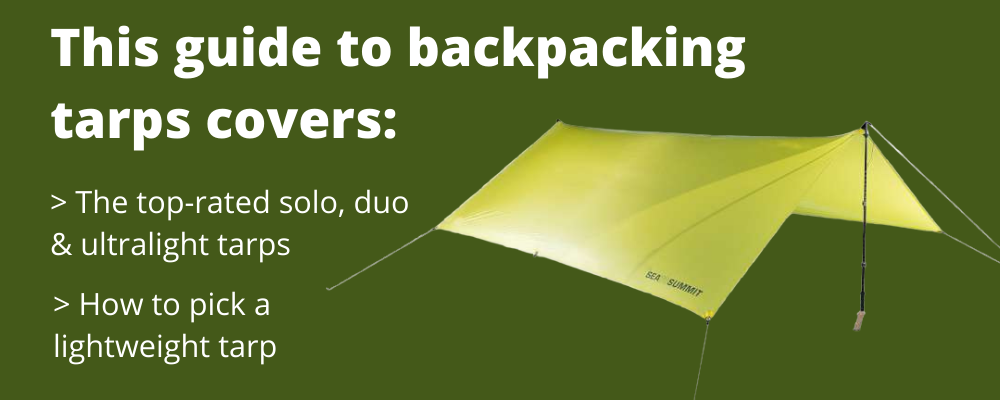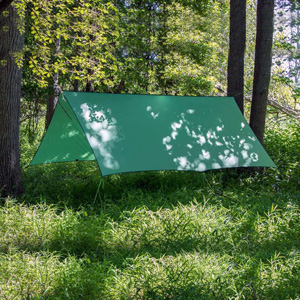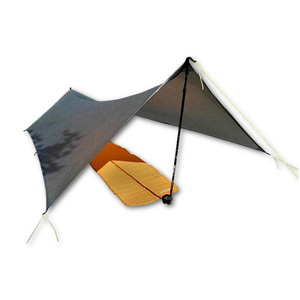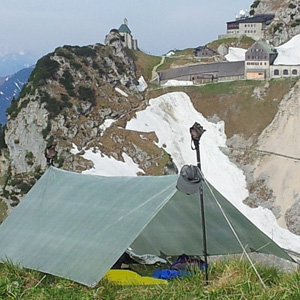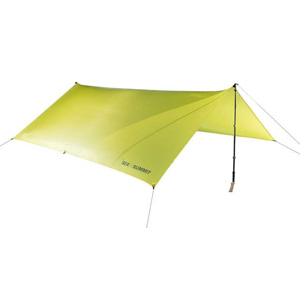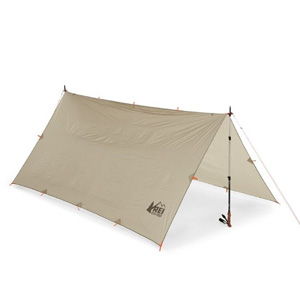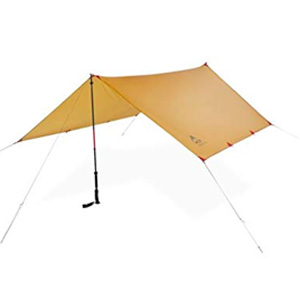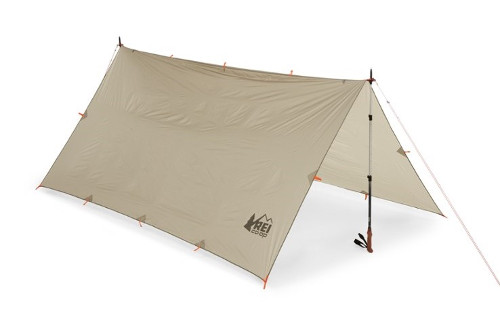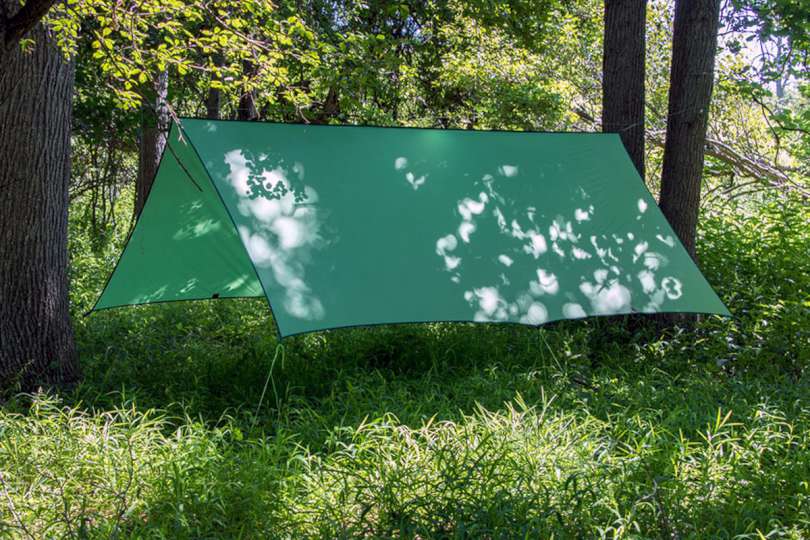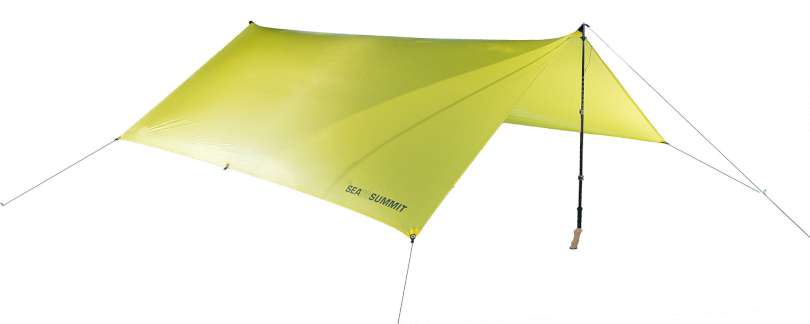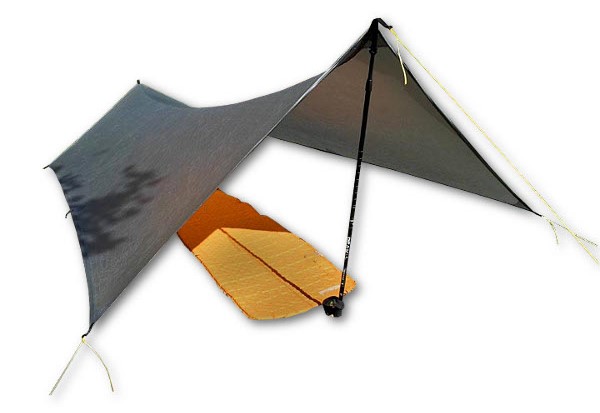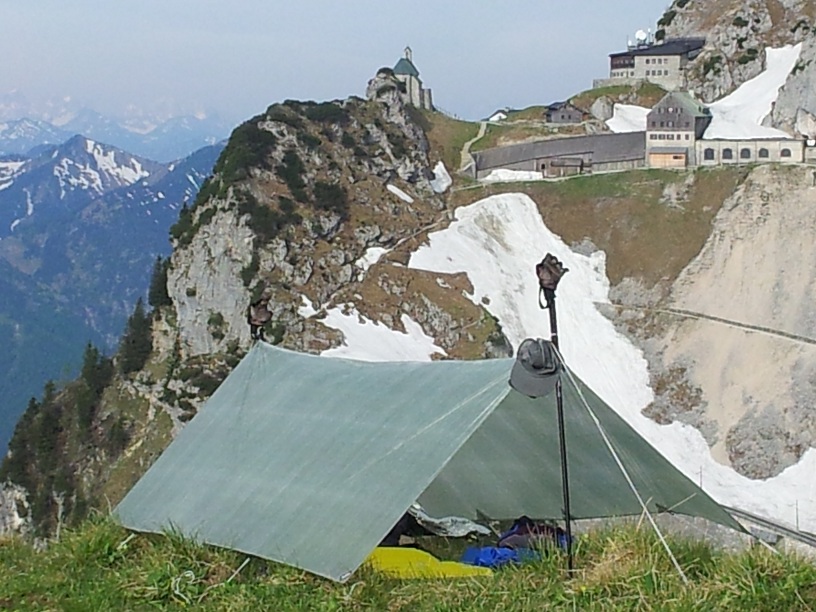Boy, have things ever changed.
Today's lightweight backpacking tarps and ultralight shelters are massive improvements on the models of even last season. And if you did any backpacking 20-30 years ago, you'll really notice how these products have evolved.
Tarps are popular shelters among backpackers seeking the lightest possible gear. They're simple, inexpensive, and highly adaptable. Once you learn how to camp using a simple backpacking tarp, you'll fall in love with how amazingly effective these ultralight backpacking shelters can be!
Understanding what makes a great lightweight backpacking tarp is just part of the battle. I'm going to explain to you what to look for in a lightweight tarp for backpacking. Then, I'll offer up some of the highest quality lightweight backpacking tarps for you to choose from. By the end of this article, you'll know exactly which lightweight backpacking tarp is right for you.
Quick Navigation
Name | Price | Weight | Rating |
|---|---|---|---|
$25.99 | 1.6 lbs | ||
$159.95 | 1.4 lbs | ||
$140.00 | 0.31 - 0.69 lbs | ||
$275.00 | 0.46 lbs | ||
$25.99 | 1.15 lbs | ||
$149.00 | 0.75 lbs | ||
$169.95 | 1 lb |
How to Choose the Best Lightweight Tarp
There is a surprising amount to know about lightweight tarps. It’s easy to get lost in the analysis of new gear. This leads to decision paralysis, overspending, and tons of wasted time. Let me help guide you through what you really need to know before picking out a lightweight tarp for backpacking.
1. Backpacking Tarp Materials
When you go to buy your new lightweight backpacking tarp, you’ll essentially be choosing between three materials. Materials like canvas, duck cloth, and oilcloth are not long-outdated. Instead, you’ll be choosing between nylon, polyester, and cuben fiber.
Nylon is a synthetic material made from plastic fibers which are extruded and aligned. These woven plastics come in many types and styles and originally were used in parachutes for soldiers during WWII. Nylon now is used in everything from car interiors to tactical equipment and lightweight waterproof tarps.Nylon for tarps is usually coated with an additional layer of silicone which creates an added layer of water repellent protection. This type of fabric is known as sil-nylon.
Polyester is ever so slightly less durable than nylon but often creates a slightly lighter weight tarp. polyester fabrics are also coated with silicone for most waterproof backpacking tarps and can come in many “weights”.
Cuben Fiber (dyneema composite) is a material that crossed into the backpacking world from high-class racing sailboats. Created from a laminate of tough, durable fibers sandwiched between two layers of plastic, cuben fiber is heat-sealed for a perfect waterproof fabric. Unlike traditional fabrics, cuben is much harder to work with, more expensive, and sports several odd quirks that make it an unusual choice of fabric. On the plus side, however, is the fact that it is substantially lighter than any other backpacking tarp materials available today.
2. Seam Sealing
This is the process by which manufacturers or users seal water out of the seams of the tarp. Seam sealing on lightweight backpacking tarps is often done by the end-user (you). Some makers offer options that allow you to have the tarp seam-sealed when you order, others do not. If this option is available, make sure to use it. Manufacturers are usually much better at seam sealing since they make dozens of tarps a week.
If you fail to seam seal your tarp, you’re going to find yourself cold, wet, and angry very quickly. Tarps usually feature a center ridge which, if left unsealed, will leak at the first sign of rain. Water makes its way through the hundreds of tiny holes punctured into the fabric by the sewing machine and then ends up in your sleeping bag!
To seam seal a tarp yourself, watch the video on how to effectively seam seal. Then, get a tube of McNett silicone seam sealer and get to work!
3. Catenary Cut Tarps
Known as cat-cut tarps for short, these tarps are engineered to be perfectly taut under tension. Using a combination of math, science, and magic manufacturers cut slight curves into the edges and seam of the tarp which improve the tightness of the tarp’s pitch.
Cat-cut tarps are awesome creations and in the correct situations, they perform flawlessly while outperforming their standard peers. However, if you’re ever forced to pitch your tarp in a cramped area or a location where a perfect pitch can’t be achieved you may be out of luck. A cat-cut tarp will sag and flap in bad weather when pitched in any arrangement other than its exact original design.
While standard tarps usually won’t pitch as tight and firm as a cat-cut tarp in ideal situations, these standard square-cut tarps are more adaptable. Some users prefer the adaptability and flexibility of a good old square tarp over their fancy cat-cut backpacking tarp counterparts.
4. Where To Buy a Lightweight Backpacking Tarp
It can actually be quite a trick figuring out where to buy your next backpacking tarp. Lightweight tarps tend to be almost exclusively made by small cottage industry manufacturers (mom and pop type stores) which can be hard to track down. On the plus side is that these small operations make some amazing equipment and you’ll be more than happy that you ordered from a small operation.
Now, I’m not saying that it’s impossible to find a lightweight tarp from large stores like REI, Backcountry.com, or other operations. You definitely can find some options there! What you won’t find are cuben fiber tarps, ultralight tarps, and some of the more bleeding edge technology going into the absolute lightest weight tarps available today.
Don’t be afraid to buy from small cottage industry makers when it comes to lightweight backpacking gear.
5. Tarp Guylines
Tarps go hand in hand with guylines. What is a guyline? Guylines are the tie-out lines that come off the edges of a tarp to secure the tarp to tent stakes (or other tie-down locations).
In order to pitch a tarp you usually need at least 4 guylines (one for each corner) and a ridgeline.
Many tarps, like the REI SL Tarp on our list, feature up to 19 or more tie-outs! You don’t need a guyline attached to each one, but some people choose to do this.
Why so many? Once you learn a handful of good knots, a few good tarp pitches, and begin to gain a creative eye for tarp pitch locations and shapes, there are nearly endless possibilities for how you can pitch!
If you don’t like to get creative, keep it simple – 4 corner guylines and a ridgeline will do you fine in 99% of scenarios.For more versatility, you can add more guylines to your kit. Use some lightweight 2mm guyline cord and tie on about 8 – 20ft of cord to each tie-out you want to use.
You can go longer or shorter depending on your preference and the pitches you like to use.
I highly recommend something visible like the Gossamer Gear EZ2C cord. I’ve been using non-reflective cord for ages and I’m too stubborn to change it, but man do I hate tripping over it in the middle of the night! Don’t be like me.
6. Other Tarp Accessories
Tarp camping is a world full of people always re-inventing the wheel. There are new goodies available monthly to make your life easier (or arguably just add more gadgets to your backpack) when it comes to pitching and using a tarp.
DutchWare Gear for ages has been inventing solutions to problems people find with backpacking tarps. There are Stingerz, Dutch Hooks, Fleaz, Wasps and more goodies than your backpack has room for!
Personally, I use a simple silpoly tarp with a couple of tie-outs and a couple of handy knots (bowline, truckers hitch, tautline hitch) and I’m good to go. But, if you feel there’s a hole in your heart when it comes to setting up your hammock, chances are good that the guys at DutchWare Gear have invented something to change the way you pitch.
Go crazy, have fun, and come up with a method of tarp camping that you can enjoy.
7. Is a Tarp Right for You
Tarps aren’t the best choice for every backpacker. Just because they happen to be capable of creating one of the lightest weight kits doesn’t necessarily mean you should use one.
Let me get you thinking about this from a few different angles and give you some food for thought to chew on before you jump into the world of tarp camping.
In the end, tarps are neither a clear win or a clear loss for everyone. If you don’t mind learning to master the tarp you’ll be rewarded with a lightweight, flexible, and versatile shelter that has nearly endless possibilities. If you want foolproof out-of-the-box deployability, look elsewhere.
There are plenty of pros and cons that I haven’t listed here but if we went into every detail and listed every eventuality that you could encounter with a tarp on the trail, this list would never end. Instead, just use the talking points above to get your mind thinking about the real practical everyday life with a tarp on the trail.
The 7 Best Lightweight Backpacking Tarps of 2020
So, now you understand some of the basics of ultralight backpacking tarps. Next, you’ll have to try to pick out a tarp that works the best for you. We all have different needs and priorities. Some may even want to buy more than one type, size, or style of tarp for different situations. Up next is a list of great lightweight backpacking tarps that will get you started!
Solo Tarps
Solo tarps, for this article, are tarps with just enough space for a single person. Depending on your needs, some may get away with a small tarp like a 7' x 6' while others may feel that an 8' x 8' is best for solo use. At the end of the day, it's all up to you but I like to err on the side of caution because a big tarp is just really nice when the rain is coming down sideways.
After using many tarps over the years, I personally like something in the 8' x 8' range for solo use just because it's more forgiving. If you really want to shave the ounces, though, you'll need to go smaller.
Note that the "ultralight" section below also contains solo options - they just happen to be super lightweight ones that make more sense in that category. If you don't see what you're looking for here, scan the duo and ultralight categories for more.
Solo tarps are, in my view, the most affordable and efficient options available for backpacking shelter. While they may be harder to learn to use than, say, a tent their benefits are inarguable.
Among REI’s better qualities are their return policies, accessibility, and being able to get your hands on a product in person. Pretty much no matter where you are there’s an REI store near you, so where’s the harm in going and getting your hands on this nice tarp to see if you like it!?
At just under 9.5′ feet square there’s enough room under this tarp for a single person to have a lavish abode. Two people can fit but you may struggle with a squeeze in bad weather unless you’re quite minimalist and experienced with tarp camping.
There are no frills here. However, the square symmetrical cut will be touted by some in-the-know as the most versatile type of tarp. Square cut tarps can be pitched in a nearly endless variety of configurations and the lack of catenary cuts means that you can get a taut pitch even if you’re in cramped spaces.
One of the things I love the most about this tarp is that each side has 5 tie-outs. These provide ample spaces to get creative with your pitches which can sometimes be necessary. Other times it’s just fun to make a wacky pitch!
For the price and a decent weight of just 12 ounces, it’s a great option, particularly for those REI loyalists out there.
MSR is part of Cascade Designs – the parent company responsible for brands like Therm-a-Rest and Platypus among others. Their products are prolific, legendary, and their customer service is on point!
All that aside, can their tarp stand up to the competition? Let’s find out.
Right out of the gate I have to complain that I found it difficult to nail down the size of this tarp. REI didn’t have it listed and MSR’s own website simply lists “length: 114 inches” with no width measurement… that’s odd!
At about one pound, however, I would rate this as a 1-2 person tarp though you can upgrade to the 100 Wing (126 inches) for more space and only 4 additional ounces if you need more room.
With only 3 tie-outs on the short side and 4 on the long side, it’s not going to be as versatile in pitching options as, say, the REI SL Tarp. That said, it’s perfectly adequate and will definitely get the job done in any situation for those who know how to handle tarp pitches.
I will say that I feel the price is a bit on the upper of the mid-range for the weight, size, and materials (20 denier ripstop nylon).
Duo Tarps
Two-person tarps need to be big enough to comfortably fit well... two people. That said, many like to use a duo tarp for solo uses given that it has a lot of extra space. While there is no "right" size for a duo tarp I would consider anything less than 8' x 8' to be too small. Remember, you need room for both people and enough overhang to reasonably protect you from the elements. Sure, some die-hard users might be able to get away with a smaller duo tarp, but that's pushing it.
Duo tarps generally aren't the lightest options out there. That said, however, don't forget that when sharing shelters you should divide the weight of the shelter by the number of people in order to get an apples-to-apples comparison. So a 23-ounce duo tarp is really just 11.5 ounces per person of shelter weight, assuming you also share other gear to balance out the weight between packs.
Duo tarps can be great options for covering your kitchen cooking space, over your hammock (though there are hammock specific tarps out there) and other versatile uses.
1. 12ft Extra Large Tarp
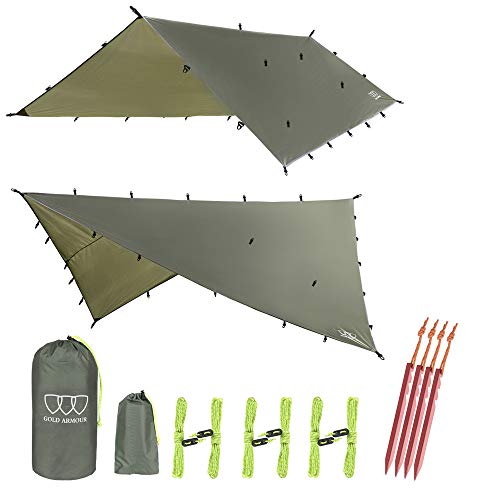
One major consideration for any purchase is the price. With lightweight backpacking tarps from small manufacturers ranging in price from $100 – $300 it can be hard to stomach the cost of a new tarp. After all, it’s just a piece of fabric, right?Well, some may find the extremely affordable price of the Vigor Tarp to be a selling point all on its own. Currently, at less than $25, this 10′ x 10′ tarp is waterproof and well-loved by users. It comes with guylines, four tent stakes, and a stuff sack. Not even some of the best lightweight backpacking tarps from other makers can say this! Honestly, it’s hard to believe that something with an affordable price like this could possibly do as well as some of the great tarps from other makers.That’s why I love that the manufacturer has a 3-year rip-free warranty. While I wish there was more specific information about the exact tarp materials and construction I suppose it really doesn’t matter. For such a low price, we have to accept some shortcomings and other users vouch for its waterproofness and function. Things like upgraded stakes, additional waterproofing, and other options could be done aftermarket if necessary.If you’re looking for a lightweight tarp that is just outright affordable, this might be the one for you!
UGQ is one of my all-time favorite gear makers. Why? Because they seem to hit the sweet spot of price, lightweight, and great customer service. With some recent changes to their products and website, things are better than ever and easier to order!
Now you can get their 12′ x 12′ silpoly lightweight backpacking tarp at the $159.95 base price. Of course, you’ll still need to choose your favorite ridgeline rope – I recommend dynaglide– and seam seal the tarp. Don’t forget to put on your own tie-outs for guylines!
The UGQ XL-SLIPOLY is available in sizes up to 15′ x 15′ which is insanely large! For a two-person hiking group, the 12′ x 12′ should be more than enough. If you’re hiking solo then you’ll have tons of room for gear or perhaps an unexpected hiking partner.
The 12′ x 12′ model starts at 23 ounces.
Note that UGQ has tarps of various sizes and can also make tarps custom size if you're looking for anything specific.
Sea to Summit is a brand that I’ve favored for years. They make everything from camp spoons to advanced shelter systems like the Escapist Tarp. I love that they always seem to bring great value at low prices on equipment that’s durable and functional.
At 10′ x 10′ and about the size of a medium Nalgene bottle when packed, these tarps are similar in design and function to the UGQ XL Sil-Poly tarps. You can snag this tarp in either medium (8.5 x 8.5) or large (10 x 10) size. Either size is appropriate for two hikers to sleep but the medium will be much more cramped. At less than 3 ounces of difference, I would encourage even the solo hiker to consider the 10 x 10 large size tarp.
Remember that the drawback then becomes a matter of being able to find a 10 x 10 space to pitch the tarp when hiking so if you anticipate camped quarters you may have to get creative.
Made from 15 denier coated nylon this tarp is squarely positioned to be a great contender in the space. I love the price tag, basic square cut shape, included line locks for quick guyline adjustment, and grommets on every tieout. That means you can easily get creative with your tarp pitches by using upside down hiking poles.
The Sea to Summit Escapist Tarp is an awesome choice if you prefer to get your gear from a major brand or if you prefer the REI guarantee and money back co-op experience.
Ultralight Tarps
While some solo tarps push the scale at a pound or more (16 ounces), ultralight solo tarps go down as low as 7 ounces or less. To get that light these tarps use expensive, cutting edge materials. They trim all the fat and provide only enough room to barely keep the elements off. There's not a lot of forgiveness in an ultralight tarp so be ready to perform at your peak if you go with an ultralight option!
These tarps are great for those looking to shed every last ounce. Also, because of their small profiles, they excel at pitching in cramped spaces where trees or boulders are too closely packed for larger tarps.
Beware that ultralight tarps are often made from incredibly lightweight fabrics. These include Dyneema composite (once called cuben fiber). This material is particularly susceptible to puncture damage compared to nylon or polyester but is orders of magnitude lighter in weight.
Ultralight tarps are pretty expensive compared to other conventional options as well. If cutting weight is your priority and you want bleeding-edge gear, look here.
If you’re looking for the absolute lightest weight backpacking tarp available the MLD Grace Tarp in Cuben Fiber might be the best pick for you. Mountain Laurel Designs is a small operation that seeks to make the lightest and most functional backpacking gear available. They’re close to the mark with the Grace Tarp!
Depending on what options you select and how you finish your Cuben Fiber Grace Tarp, you’ll be left with an ultralight backpacking shelter that comes in between 7-12 ounces. That’s roughly between 1/2 and 3/4 of a pound for your entire shelter! Compared to lightweight backpacking tents, the MLD Grace Tarp is easily 1/4 of the weight of even the lightest tents.
Of course, Cuben Fiber is a finicky material that can be hard to work with. It’s fragile in certain conditions and requires careful attention and maintenance. If that doesn’t sound like your thing, then consider the Grace Tarp in SilNylon. MLD will even seam seal the SilNylon version for you which adds about 1 oz to the overall weight.
Be careful comparing apples to apples on these tarps though. The MLD Grace Tarp is much smaller than the UGQ Silpoly tarp. MLD’s Grace Tarp measures 7′ x 5′ x 9′ (front x rear x length). UGQ’s XL tarps are 12′ x 12′ x 12′. When the rain really starts pounding, you might wish you had more coverage!
Note that MLD has many different size and shape offerings for their tarps. If you're looking for something specific, check their other offerings or contact them with special needs.
Zpacks is a company that specializes exclusively in the use of cuben fiber for backpacking equipment. Now technically known as “Dyneema Composite” the cuben fiber material has evolved from its humble roots.
This cuben fiber backpacking tarp is made from .51 oz/sqyd olive colored cuben. There are reinforced tie-outs for guylines and the ridgeline is totally bonded for a waterproof seal every time. No need to seam seal the tarp because the cuben fiber layers are bonded together using heat. That means there’s a perfect waterproof seal on every seam without the need for additional silicone.
While Zpacks typically has some of the highest prices on backpacking gear, it’s for a reason. Their 8.5′ x 10′ tarp weighs only 7.7 ounces straight from the factory. That’s less than half a pound for your backpacking shelter! Not bad when you consider the other options available.
Don’t get too wrapped up in trying to shave ounces that you pick a tarp that is too small for you. There’s nothing glorious about trying to huddle under the edges of a tiny tarp while the Appalachians dump a thunderstorm on you in the middle of the night.
The Zpacks cuben fiber tarps are great high-quality choices if you demand the lightest!
It's worth noting that Zpacks has many different size and shape tarps to offer. Check out their entire range of products if you're looking for something specific.
Conclusion
Lightweight backpacking tarps come in many sizes, shapes, and styles. Some backpackers even choose to make their own, since it can be hard to find just the right one. Whatever tarp you choose for your hiking and backpacking trips, be sure it truly fits your needs. There’s always a balance between weight, comfort, and function.
If you’re tight on cash, go for the Vigor Tarp which won’t cost you much at all. Be prepared to do some modifications and upgrades when necessary, though. For those looking to find the best balance of weight, size, price, and function the UGQ Tarps are my favorite. No one can deny that the Mountain Laurel Design tarps and Zpacks tarps may be the absolute lightest backpacking tarps available though.
Remember to test your backpacking tarps before taking them on a trip. Spend the night in your backyard sleeping under the quilt and see if it’s big enough. Check for leaks on a rainy night, and be sure to learn how to take care of your tarp properly. Then you’ll be ready for anything when you take your new lightweight backpacking tarp on to the trail!

